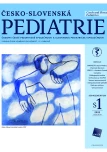-
Medical journals
- Career
Tularemia – case series
Authors: Slováková Lea 1; Jendrálová Zuzana 1; Čepelová Michaela 3; Cyprová Soňa 3; Bloomfield Markéta 1,2
Authors‘ workplace: Pediatrická klinika, 1. lékařská fakulta Univerzity Karlovy, Fakultní Thomayerova nemocnice, Praha 1; Ústav imunologie, 2. lékařská fakulta Univerzity Karlovy, FN Motol, Praha 2; Klinika dětské hematologie a onkologie, 2. lékařská fakulta Univerzity Karlovy, FN Motol, Praha 3
Published in: Čes-slov Pediat 2023; 78 (Supplementum 1): 24-29.
Category: Case Histories
doi: https://doi.org/10.55095/CSPediatrie2023/029Overview
Lymphadenopathy is a common symptom in children, yet sometimes it may represent a differential diagnostic pitfall. Tularemia is one of the rare causes of lymphadenopathy in childhood. A clinical suspicion should arise in cases with history of insect bite or animal contact, granulomatous inflammation in biopsy specimen, negative culture results, and/or in cases which fail to respond to first-line antibiotics. Hereby, three cases of children with unexplained lymphadenopathy are presented, highlighting the practical aspects and issues potentially associated with the diagnosis and management of tularemia.
Keywords:
tularemia – Serology – Francisella tularensis – children – ulceroglandular form – lymfadenopathy
Sources
1. I mbimbo C, Karrer U, Wittwer M, et al. Tularemia in children and adolescents. Pediatr Infect Dis J 2020; 39 (12): e435–e438.
2. European Centre for Disease Prevention and Control. Tularaemia, Annual epidemiological report for 2019. Dostupné z: https://www.ecdc. europa.eu/en/publications-data/tularaemia-annual-epidemiological-report - 2019
3. Výskyt vybraných hlášených infekcí v České republice, kumulace leden – prosinec 2019. Zprávy Centra epidemiologie a mikrobiologie. Praha: SZÚ 2019; 28(11-12): 423–425.
4. Penn RL. Francisella tularensis (Tularemia). Mendell, Douglas and J.E. Bennet’s Practice of Infectious Diseases. 8th edition. Philadelphia: Elsevier Saunders 2015 : 2590–2602.
5. Janda A, Fencl F, Kabelka Z, et al. Tularemie: vzácná příčina horečky a lymfadenopatie v kojeneckém věku. Čes-slov Pediat 2008; 63 (3): 137–147.
6. Centers for Disease Control and Prevention. Tularemia. Dostupné z: https://www.cdc.gov/tularemia
7. World Health Organization. WHO Guidelines on tularaemia. 2007. Dostupné z: https://apps.who.int/iris/handle/10665/43793
8. A merican Academy of Pediatrics. 2021 Red Book: Report of the Committee on Infectious Disease – single chapter Tularemia, 32nd edition. Illinois: Academy of Pediatrics 2021.
9. Syrjälä H. Peripheral blood leukocyte counts, erythrocyte sedimentation rate and C-reactive protein in tularemia caused by the type B strain of Francisella tularensis. Infection. 1986; 14 (2): 51–54.
10. S obotková K. Krční uzlinový syndrom z pohledu otorinolaryngologa. Čes - -slov Pediat 2015; 70 (3): 166–173.
11. M aurin M. Francisella tularensis, tularemia and serological diagnosis. Front Cell Infect Microbiol 2020; 26 (10): 512090.
Labels
Neonatology Paediatrics General practitioner for children and adolescents
Article was published inCzech-Slovak Pediatrics

2023 Issue Supplementum 1-
All articles in this issue
- Květa Válová: Rozháněč mraků
- Editorial
- Vaccination of children against COVID-19
- Infections caused by respiratory syncytial viruses – epidemiology, clinical picture, diagnosis, prevention and treatment options
- Tick-borne tularemia in a four-year-old girl
- Tularemia – case series
- Pityriasis rosea Gibert
- Paediatric care at Itibo Health Centre in Kenya
- Pohlednice z Kamerunu
- Czech-Slovak Pediatrics
- Journal archive
- Current issue
- Online only
- About the journal
Most read in this issue- Pityriasis rosea Gibert
- Infections caused by respiratory syncytial viruses – epidemiology, clinical picture, diagnosis, prevention and treatment options
- Tularemia – case series
- Tick-borne tularemia in a four-year-old girl
Login#ADS_BOTTOM_SCRIPTS#Forgotten passwordEnter the email address that you registered with. We will send you instructions on how to set a new password.
- Career

